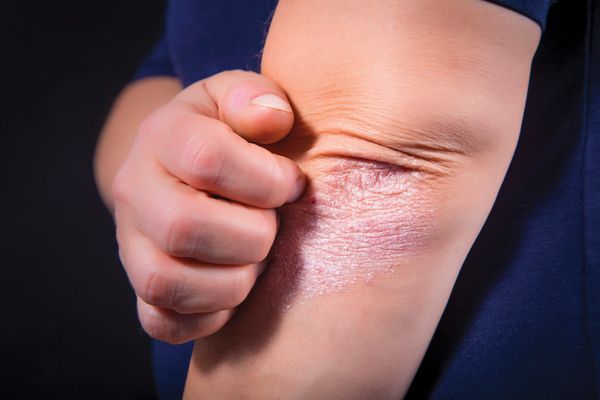Psoriasis
Psoriasis is a chronic autoimmunedisease, which is manifested by dry skin patches that are raised above the skin, predominantly have a red-purple hue and are covered in thick slivery-white scales. The name “psoriasis” originates in Greek— “psora” in Greek means “itch”, and indeed, many psoriasis patients suffer from itching, when the severity of the symptoms varies from one person to another. The lesions are mostly common on the scalp, elbows, knees, back, chest, abdomen, nails and genitalia, and may vary in size and cover either small or extensive areas of the body.
The duration of the disease cannot be predicted, since there are no “rules” to its pathology, and therefore, in Chinese medicine it is called “the shrewd disease”. Since the disease also includes a genetic background, it is impossible to know when it will be cured or whether it is going to return at some point in life.
Approximately 3% of the population suffers from psoriasis. The disease appears among men and women in equal rates, and is more common among people of European origin. The onset of the disease usually occurs between the ages of 20–30 or 50–60, but it can appear at any age and even in children.
The Disease’s Symptoms
In Chinese medicine, psoriasis is called Bai Bi= a rash with patches covered in scales, and also Song Pi Xyam= conifers’ bark. And indeed, the disease is manifested by a, mostly symmetrical, skin rash of red patches covered in thick white scales. Some of the patients sometimes experience itching, and often the scratching and removing of the scales leads to pinpoint bleeding. It is important to note that psoriasis is not a contagious disease, and there is no risk involved in coming into contact (even with the lesions themselves) with a person suffering from it.
Types of Psoriasis
The disease can be manifested by a rash of different types; each type has a name that describes it.
- Plaque (psoriasis vulgaris)—the most common form of psoriasis, in which the scales appear predominantly on the areas of the joints and scalp, the knees and nails.
- Guttate psoriasis— looks like tiny droplets scattered across the chest, abdomen and back, and usually appears after an acute bacterial infection (strep throat— streptococcal pharyngitis), and mainly affects children and young people.
- Inverse psoriasis—scales that appear in internal areas and skinfolds, such as the armpits, navel and groin.
- Psoriatic arthritis—psoriasis that is accompanied by arthritis.
- Pustular psoriasis—an uncommon form of psoriasis, in which pus-filled pustules appear on the hands and feet. The pus does not contain bacteria, and is therefore non-contagious.
- Erythrodermic psoriasis—a condition in which the entire surface of the skin is affect by psoriasis and the skin is reddish.
What Are the Causes for Psoriasis?
As in all autoimmune diseases, the cause for the inflammatory condition is the immune system itself. In psoriasis’s case, the immune system inadvertently identifies the skin cells as a pathogen, and thus attacks them. The direct cause for psoriasis is unknown. Nevertheless, it has been found that several factors are involved in its appearance and onset:
- Genetic predisposition— in 70% of the cases, there is an indubitably known genetic connection. For this reason, it is impossible to know when the disease will be cured and whether it will return at any stage in life.
- An inflammatory process and a multiplicity of blood vessels—in the dermis layer. The inflammation cells and the multiplicity of blood vessels yield the redness.
- The accelerated proliferation of the squamous cells in the epidermis—normally, the squamous cells are replaced once a month. In psoriasis, the process is shortened to only a few days, with the number of cells that undergo division in psoriatic skin being 27 times greater than in healthy skin. As a result, new skin cells accumulate on the epidermis layer in an excessively rapid pace, before the old cells have had time to fall, thus creating a thick white layer of scales.
- Mental stress, trauma, and stressful situations—psoriasis can outbreak or worsen due to stressful situations. Approximately 39% of psoriasis patients report about a stressful event that took place within the month prior to the outbreak of the disease.
- A traumatic experience involving the stomach or the digestive system (often due to taking antibiotics), which results in the body’s failure to digest certain proteins.
- Nutritional deficiencies— vitamin A, zinc, vitamin D
- Defective liver function.
- Protein absorption problems.
- Excessive consumption of alcohol and animal fats.
- Smoking—statistical data indicates a higher incidence of psoriasis among smokers.
Diagnosis Methods:
The following tests may assist in the evaluation of the possible causes for psoriasis:
- Hormone levels in the blood—it is recommended to check: the thyroid, DHEA, cortisol, testosterone, IGF-1 growth hormone, estrogen and progesterone.
- Vitamin and mineral levels—to confirm nutritional deficiencies.
- The function of the digestive system and the existence of bacteria, viruses, parasites (stool culture).
- Allergy or sensitivity to food or environmental factors—blood test.
